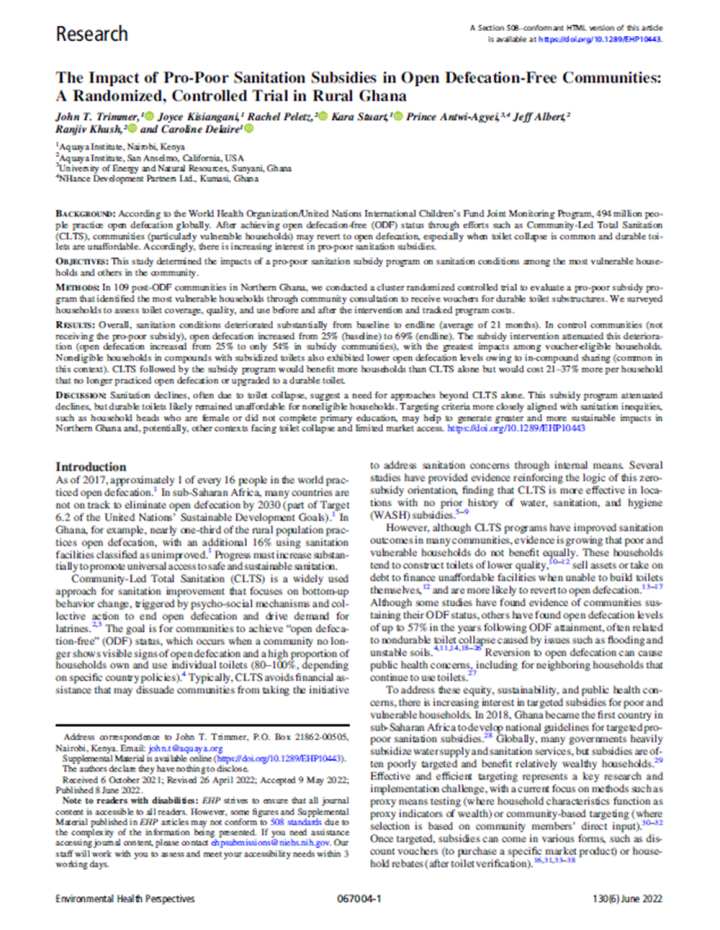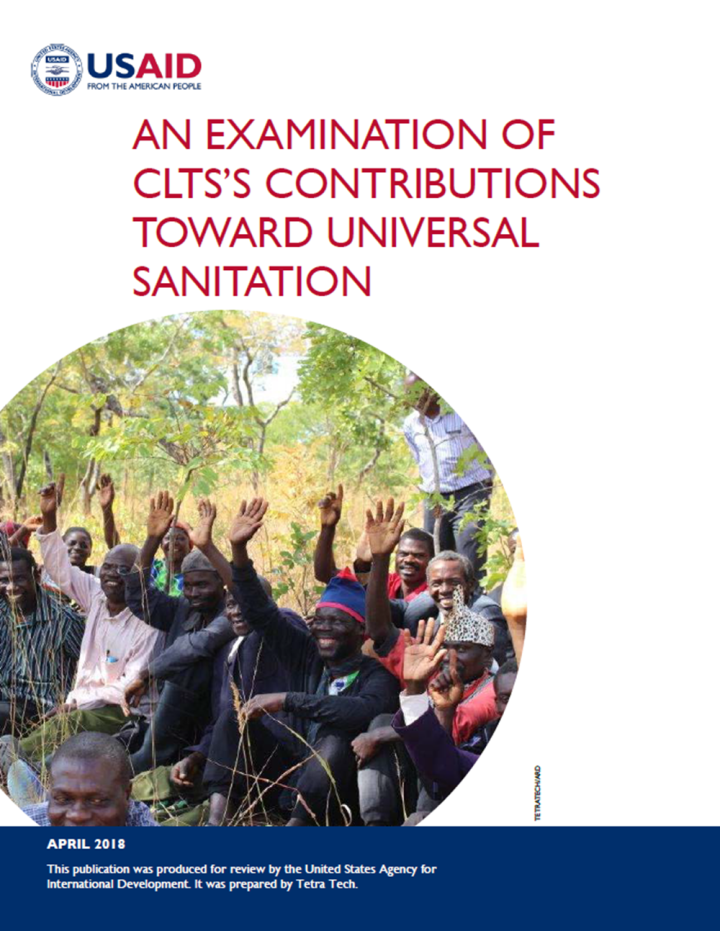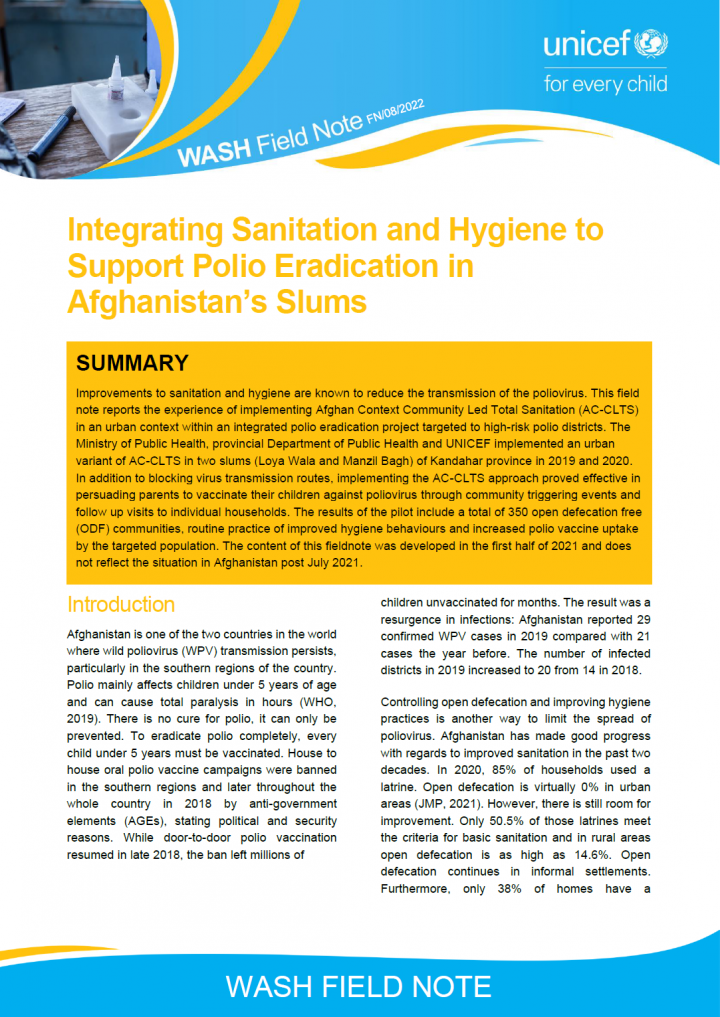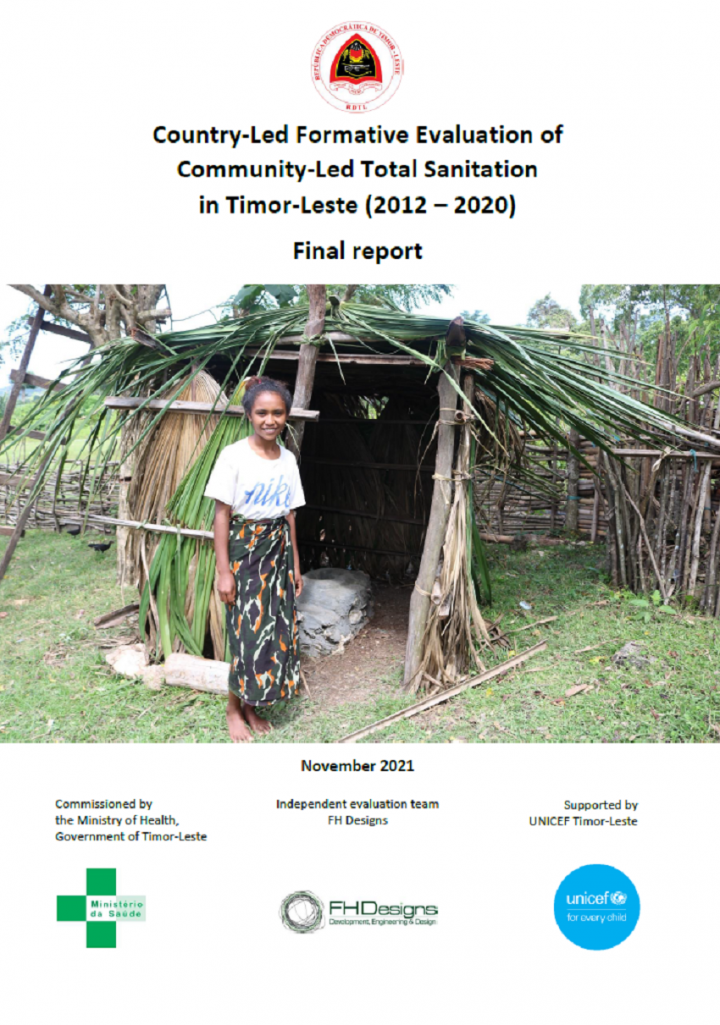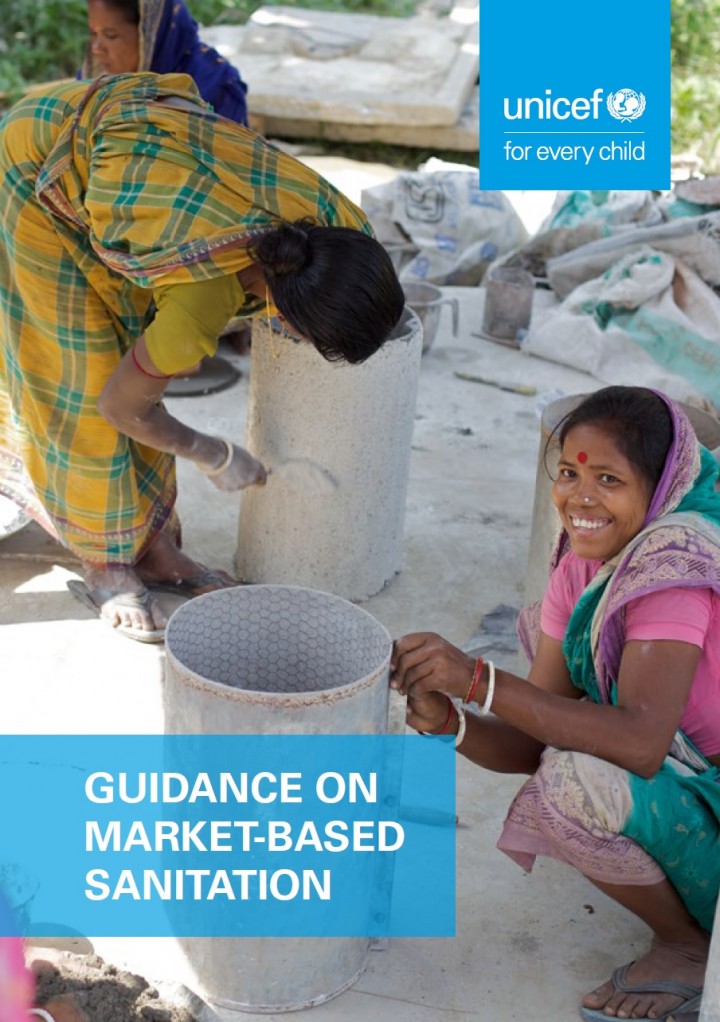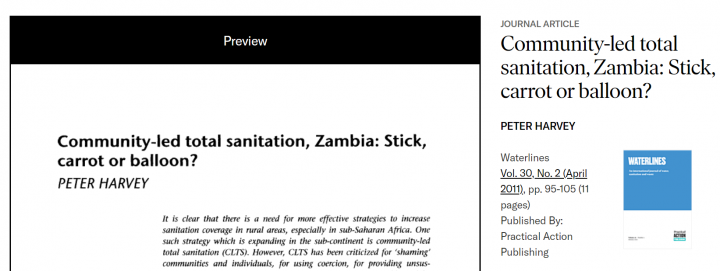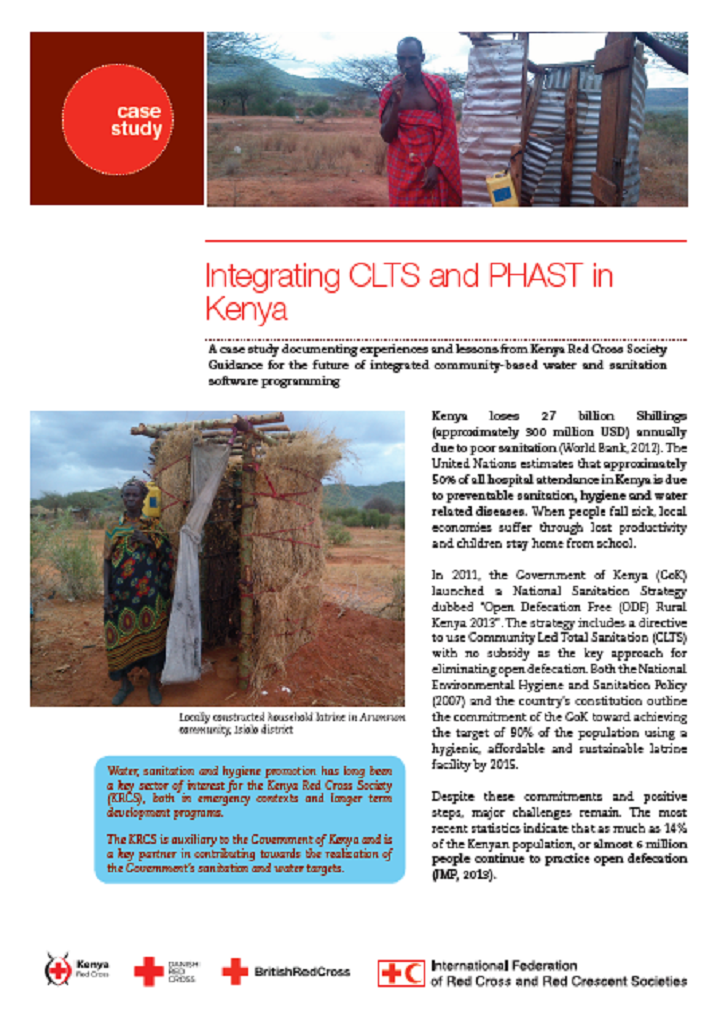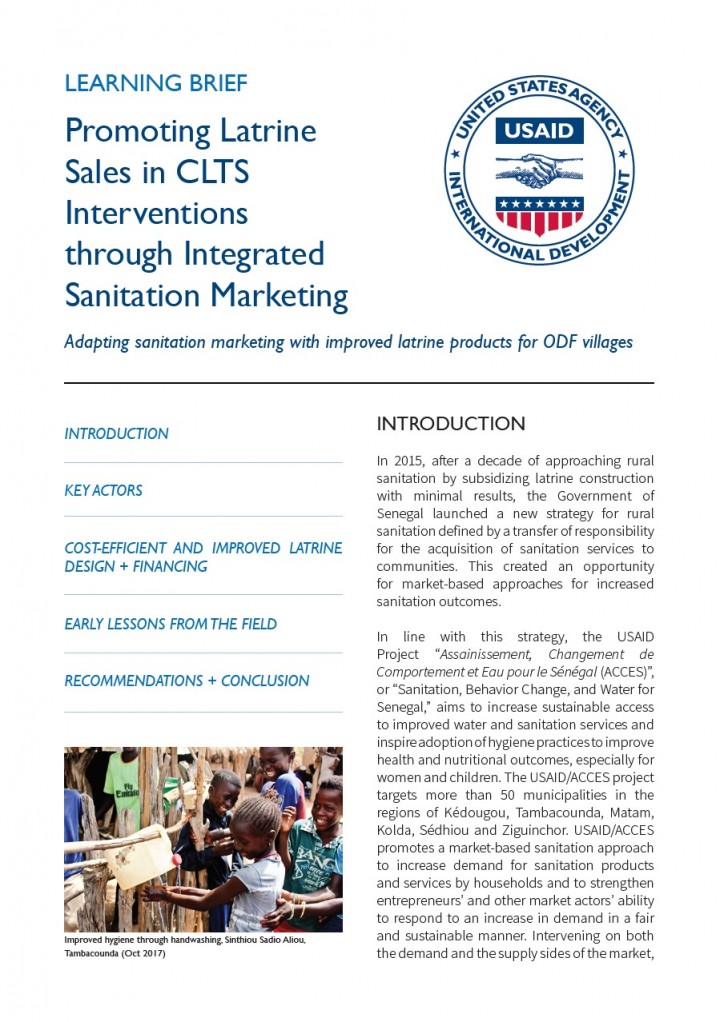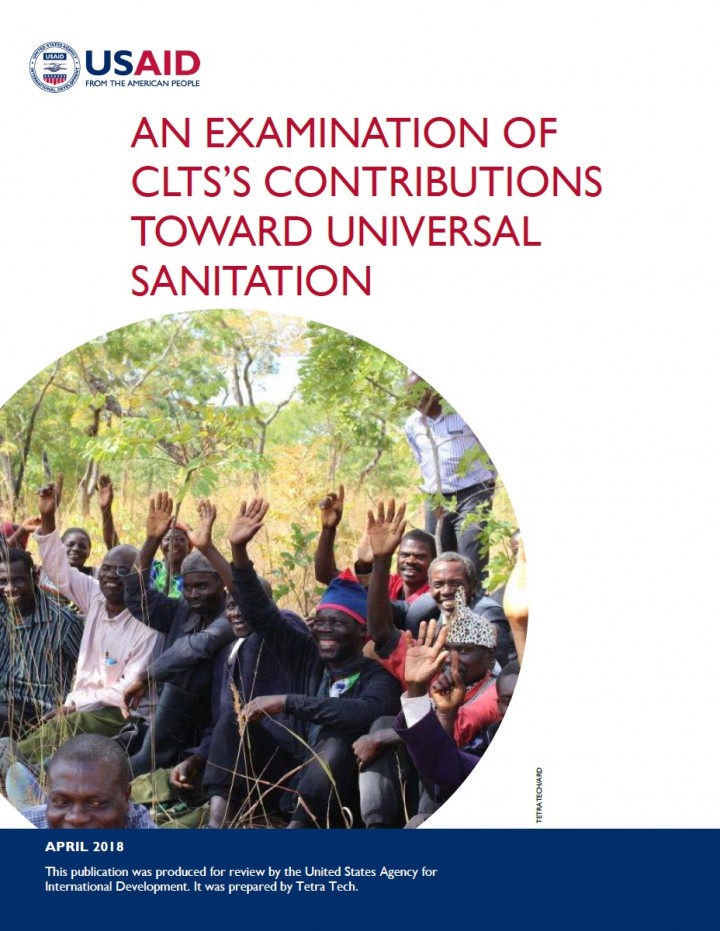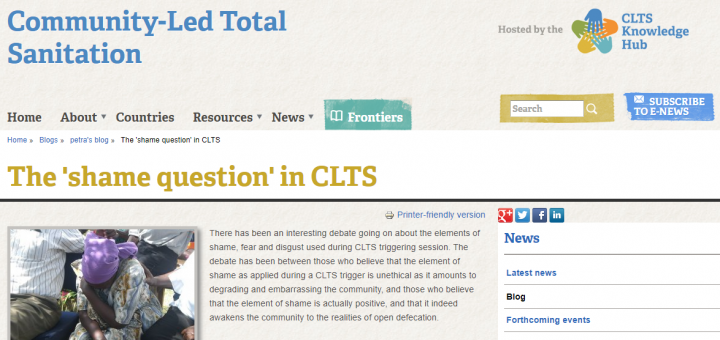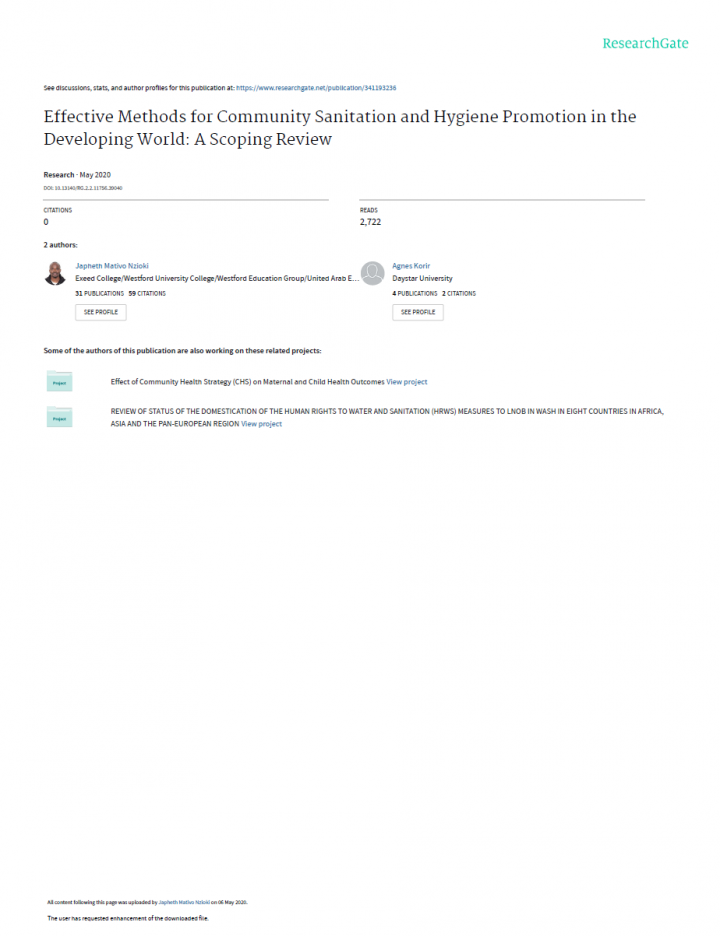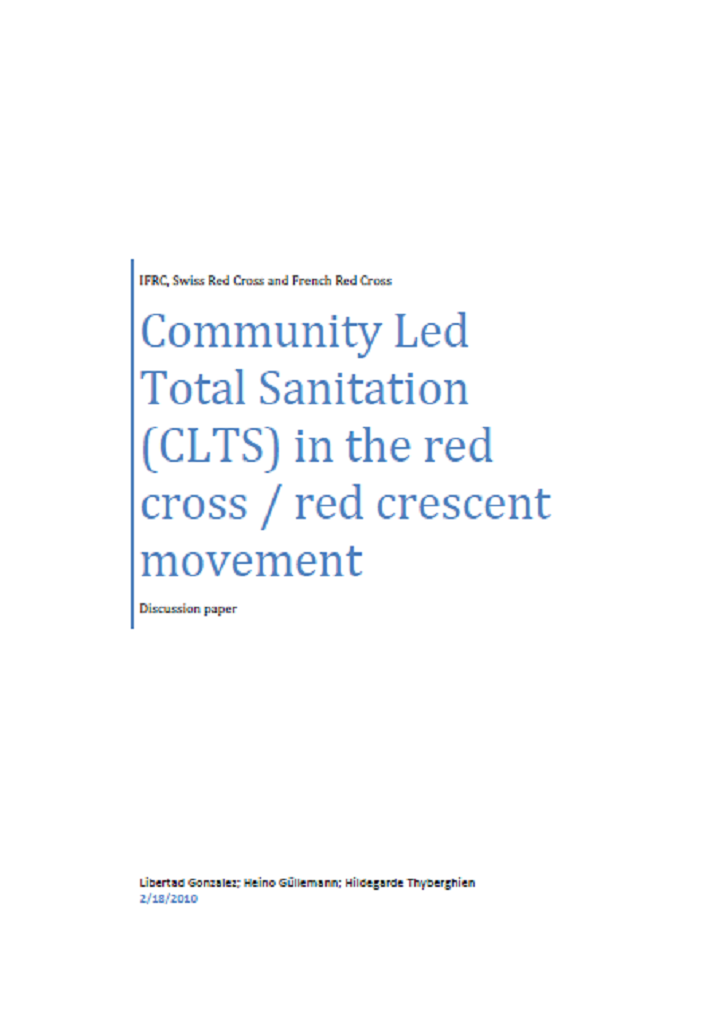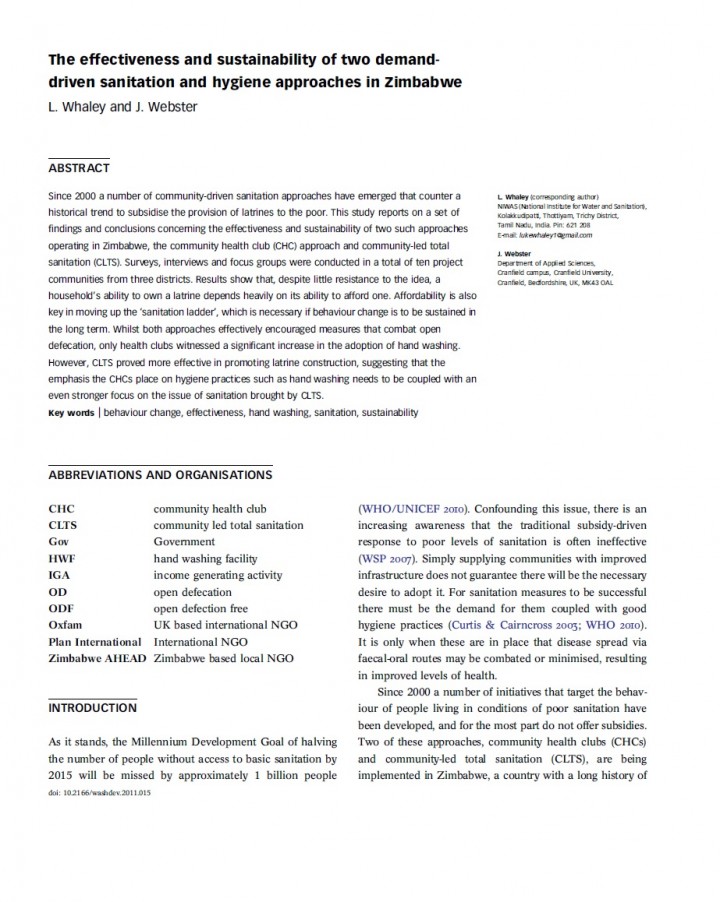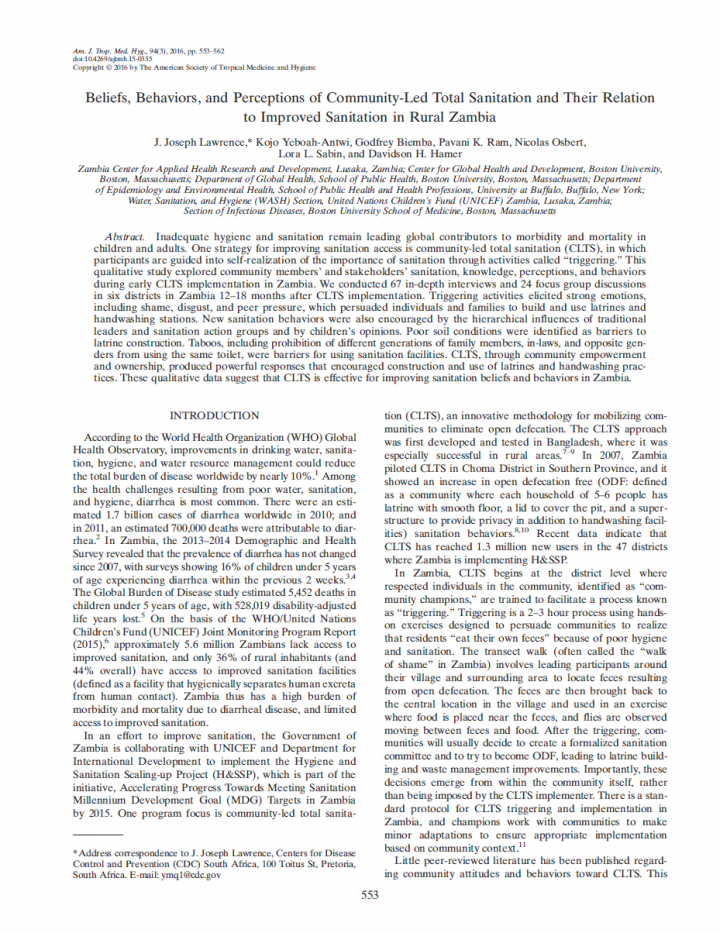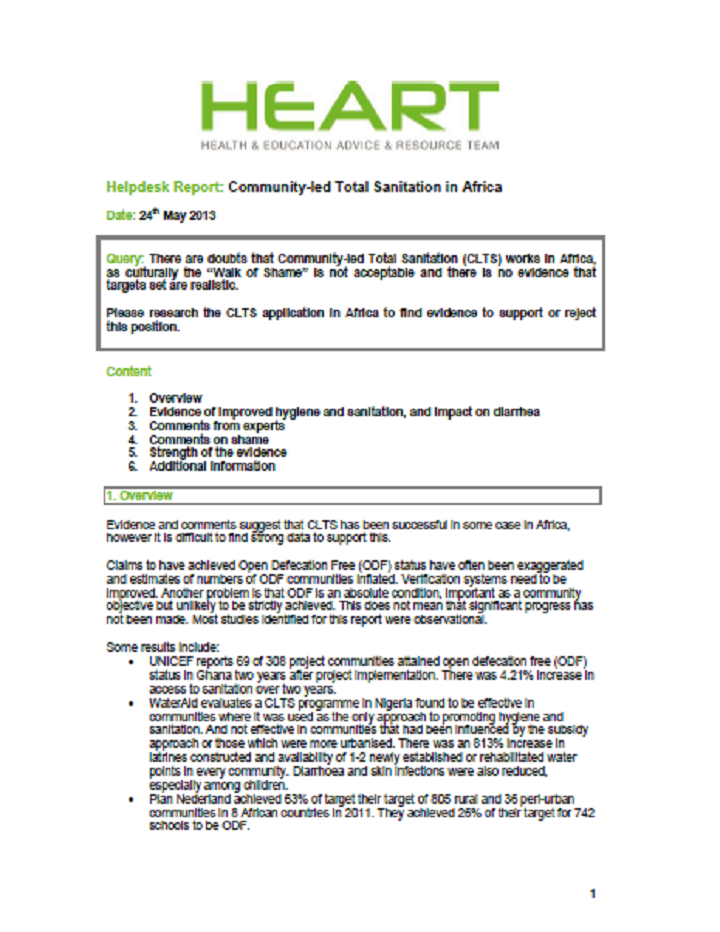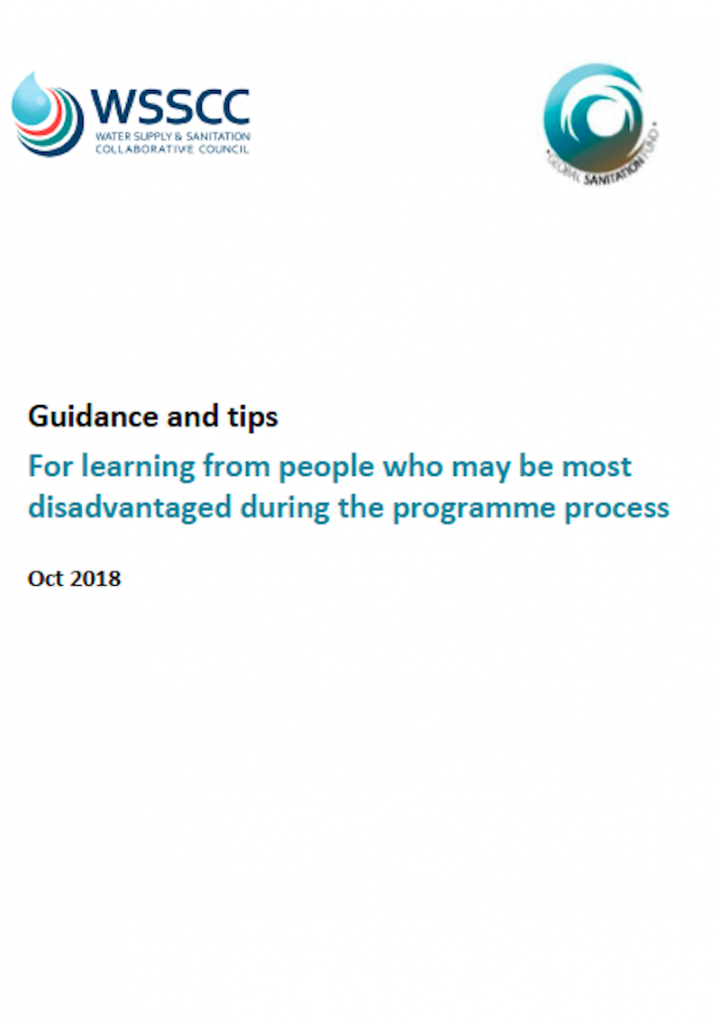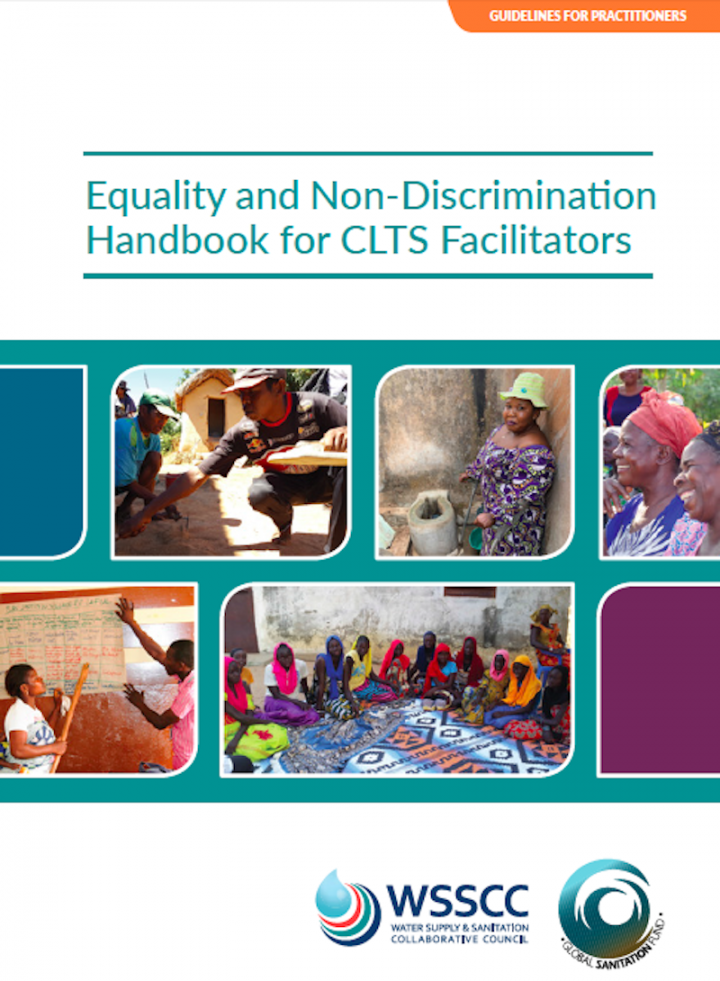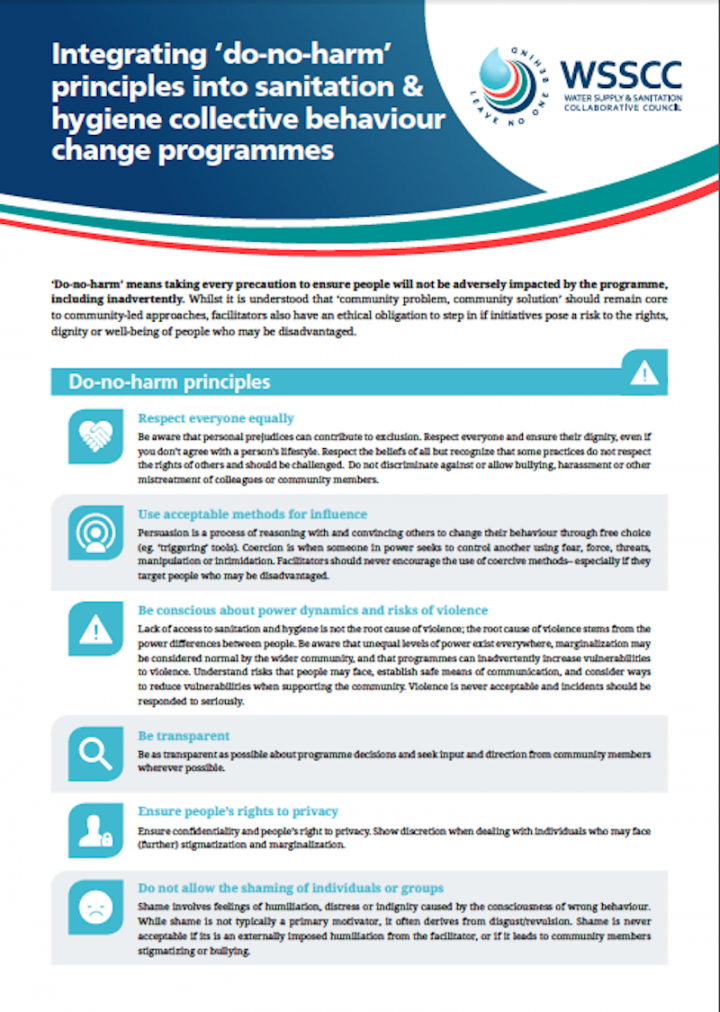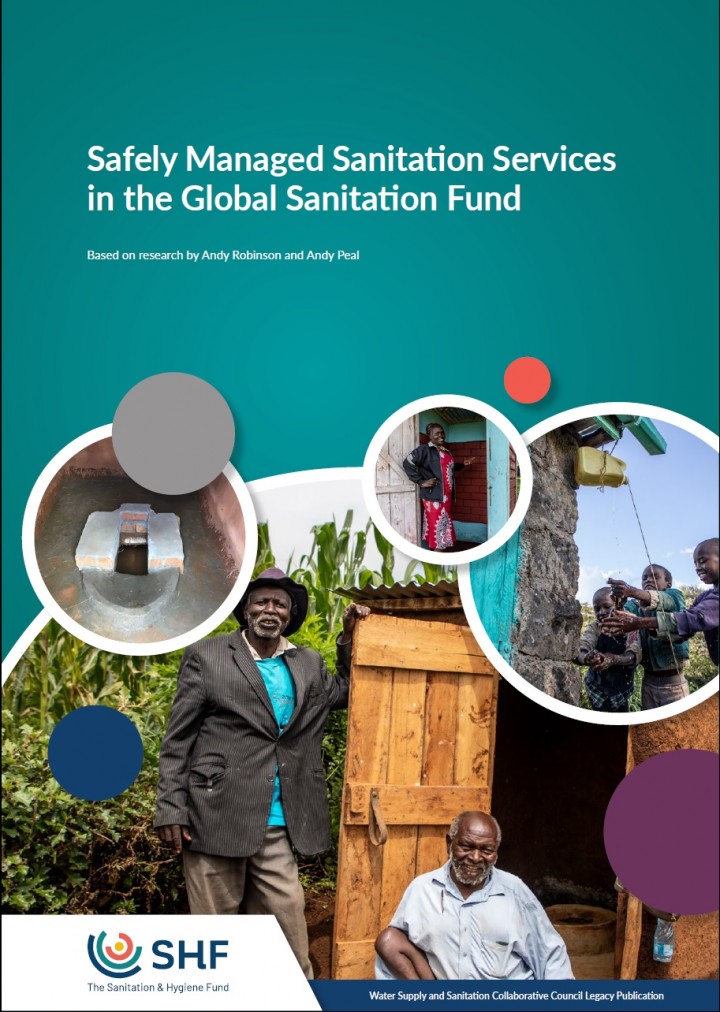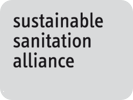John T. Trimmer, Joyce Kisiangani, Rachel Peletz, Kara Stuart, Prince Antwi-Agyei, Jeff Albert, Ranjiv Khush, and Caroline Delaire (2022) The Impact of Pro-Poor Sanitation Subsidies in Open Defecation-Free Communities: A Randomized,Controlled Trial in Rural Ghana
According to the World Health Organization/United Nations International Children’s Fund Joint Monitoring Program, 494 million people practice open defecation globally. After achieving open defecation-free (ODF) status through efforts such as Community-Led Total Sanitation (CLTS), communities (particularly vulnerable households) may revert to open defecation, especially when toilet collapse is common and durable toilets are unaffordable. Accordingly, there is increasing interest in pro-poor sanitation subsidies. This study, produced […]
USAID (2018) An examination of CLTS’s contributions toward universal sanitation
This desk review examines the refereed and gray literature on Community Led Total Sanitation (CLTS), with the central objective of assessing the knowledge base on best practices and identifying evidence gaps to inform the project’s research agenda (to generate findings that improve policy and practice). The review offers a description of the CLTS intervention, tracing its evolution in theory and practice from Southeast Asia to its […]
UNICEF (2022) Integrating Sanitation and Hygiene to Support Polio Eradication in Afghanistan’s Slums
Improvements to sanitation and hygiene are known to reduce the transmission of the poliovirus. This field note reports the experience of implementing Afghan Context Community Led Total Sanitation (AC-CLTS) in an urban context within an integrated polio eradication project targeted to high-risk polio districts. The Ministry of Public Health, provincial Department of Public Health and UNICEF implemented an urban variant of AC-CLTS in two slums […]
Timor-Leste Ministry of Health and UNICEF Timor-Leste (2021) Country-Led Formative Evaluation of Community-Led Total Sanitation in Timor-Leste (2012 – 2020)
This evaluation examines a broad national programme of ‘community-led total sanitation’ (CLTS) style sanitation interventions conducted in Timor-Leste by the government, NGOs and multi-lateral and bi-lateral stakeholders from 2012 to 2020. It was commissioned by the Government of Timor-Leste (GoTL) Ministry of Health (MoH) in collaboration with UNICEF Timor-Leste. The evaluation was conducted by FH Designs between December 2019 and March 2021, a period which […]
UNICEF (2020) Guidance on Market-Based Sanitation
One of the key programming approaches adopted in UNICEF’s Strategy for WASH (2016-2030) is to build sustainable markets for sanitation goods and services. Market-based sanitation (MBS) is defined as a development approach to improve sanitation in a country by building the sanitation market of goods and services for which the customer makes a full or partial monetary contribution (with savings and/or cash equivalents) toward the […]
Harvey, P. (2011) Community-Led Total Sanitation, Zambia: Stick Carrot or Ballon?
It is clear that there is a need for more effective strategies to increase sanitation coverage in rural areas, especially in sub-Saharan Africa. One such strategy which is expanding in the sub-continent is community-led total sanitation (CLTS). However, CLTS has been criticized for 'shaming' communities.
Kenya Red Cross (2018) Integrating CLTS and PHAST in Kenya
A case study documenting experiences and lessons from Kenya Red Cross Society Guidance for the future of integrated community-based water and sanitation software programming.
USAID (2020) Promoting Latrine Sales in CLTS Interventions through Integrated Sanitation Marketing Learning Brief
In 2015, after a decade of approaching rural sanitation by subsidizing latrine construction with minimal results, the Government of Senegal launched a new strategy for rural sanitation defined by a transfer of responsibility for the acquisition of sanitation services to communities. This created an opportunity for market-based approaches for increased sanitation outcomes. In line with this strategy, the USAID Project “Assainissement, Changement de Comportement et […]
USAID (2018) An Examination of CLTS’s Contributions Toward Universal Sanitation
Community-led Total Sanitation (CLTS) is a revolutionary idea and an inspiring practice. The enthusiasm of its many adherents in government and civil society is understandable. This desk review examines the refereed and gray literature on CLTS, with the central objective of assessing the knowledge base on best practices and identifying evidence gaps to inform the project’s research agenda (to generate findings that improve policy and […]
Otieno, P. V. (2012) The 'Shame Question' in CLTS.
There has been an interesting debate going on about the elements of shame, fear and disgust used during CLTS triggering session. The debate has been between those who believe that the element of shame as applied during a CLTS trigger is unethical as it amounts to degrading and embarrassing the community, and those who believe that the element of shame is actually positive, and that […]
Nzioki, M.N., Korir, A (2020) Effective Methods for Community Sanitation and Hygiene Promotion in the Developing World: A Scoping Review
World Health Organization data on the burden of disease shows that approximately 3.1% of deaths (1.7 million) and 3.7% (54.2 million) of disability-adjusted-life-years (DALYs) worldwide are attributable to unsafe water, sanitation and hygiene. In Africa and developing countries in South East Asia 4-8% of all disease burdens are attributable to poor hygiene and sanitation. Over 99.8% of all deaths in developing world are attributable to […]
Gonzales, L., Güllemann, H., Thyberghien, H. (2010) Community Led Total Sanitation in the Red Cross / Red Crescent Movement. Discussion Paper
PHAST shares the same participatory learning principles as CLTS, which aim at gaining self-esteem, believing in people‟s ability to solve basic problems with their own resources. PHAST and CLTS also have in common the technical scope in their original conception, since both have been designed to focus on sanitation issues in rural communities. However, PHAST in Red Cross / Red Crescent has been successful in […]
Whaley, L., Webster, J. (2011) The Effectiveness and Sustainability of Two Demand-Driven Sanitation and Hygiene Approaches in Zimbabwe
Since 2000 a number of community-driven sanitation approaches have emerged that counter a historical trend to subsidise the provision of latrines to the poor. This study reports on a set of findings and conclusions concerning the effectiveness and sustainability of two such approaches operating in Zimbabwe, the community health club (CHC) approach and community-led total sanitation (CLTS). Surveys, interviews and focus groups were conducted in […]
Lawrence, J. J., Yeboah-Antwi, K., Biemba, G., Ram, P. K., Osbert, N., Sabin, L. L., Hamer, D. H. (2016) Beliefs, Behaviors, and Perceptions of Community-Led Total Sanitation and Their Relation to Improved Sanitation in Rural Zambia
Inadequate hygiene and sanitation remain leading global contributors to morbidity and mortality in children and adults. One strategy for improving sanitation access is community-led total sanitation (CLTS), in which participants are guided into self-realization of the importance of sanitation through activities called “triggering.” This qualitative study explored community members' and stakeholders' sanitation, knowledge, perceptions, and behaviors during early CLTS implementation in Zambia. We conducted 67 […]
Bolton, L., Kanguru, L. (2013) Helpdesk Report: Community-Led Total Sanitation in Africa
Evidence and comments suggest that CLTS has been successful in some cases in Africa, however it is difficult to find strong data to support this. Claims to have achieved Open Defecation Free (ODF) status have often been exaggerated and estimates of numbers of ODF communities inflated. Verification systems need to be improved. Another problem is that ODF is an absolute condition, important as a community objective […]
Balfour, N., Otieno, P., Mutai, C., Thomas, A. (2014) CLTS in Fragile and Insecure Contexts: Experience from Somalia and South Sudan
During more than 20 years of civil conflict in both Somalia and South Sudan, sanitation interventions were mostly limited to construction of emergency latrines for affected populations or education on sanitation and hygiene, using the Participatory Hygiene and Sanitation Transformation (PHAST) approach, followed by fully subsidised latrine programmes for selected households. There is little evidence that these interventions achieved the desired results: recent surveys in Somalia […]
House, S. (2018) Equality and Non-Discrimination: Learning From People Who May Be Most Disadvantaged
A practical guide for the Global Sanitation Fund (GSF) supported programme teams and Community Led Total Sanitation (CLTS) facilitators on how to collect information related to Equality and Non-Discrimination (EQND) at community level, and in particular to learn from people who may be disadvantaged. This guide provides insights into the key ethics principles for information gathering and documentation, offers practical qualitative learning and participatory tools, […]
WSSCC (2019) Equality and Non-Discrimination Handbook for CLTS Facilitators
The Equality and Non-discrimination (EQND) and Community-led Total Sanitation (CLTS) Handbook provides practical guidance for ensuring that behaviour change interventions leave no one behind. Drawing on experience from across the sector, this handbook is specifically targeted towards those implementing or supervising CLTS interventions at the community level. Key features include a summary of EQND principles, step-by-step guidance on applying these principles during pre-triggering, triggering meetings, […]
WSSCC (2019) 'Do No Harm' Principles in Behaviour Change Programming
‘Do-no-harm’ means taking every precaution to ensure people will not be adversely impacted by the programme, including inadvertently. Whilst it is understood that ‘community problem, community solution’ should remain core to community-led approaches, facilitators also have an ethical obligation to step in if initiatives pose a risk to the rights, dignity or well-being of people who may be disadvantaged. For a more in-depth read on […]
Robinson, A., Peal, A. (2020) Safely Managed Sanitation Services in the Global Sanitation Fund
Sustainable Development Goal 6 for water and sanitation calls for the realization of safely managed services (SMSS) for everyone by 2030. While there has been significant research and implementation to improve the sanitation service chain in urban settings, little guidance is available on how to achieve and sustain SMSS in rural contexts. In 2019, WSSCC commissioned this study to examine to what extent Global Sanitation […]
